Abstract
The construction industry, a significant contributor to global carbon emissions, is pivotal in implementing carbon reduction strategies. This study delves into the carbon emissions associated with the construction stage of prefabricated buildings (CSPB), a burgeoning field of research. Utilizing the CiteSpace knowledge graph visualization software, we comprehensively analyzed literature from the Web of Science (WoS) database. Our study encompasses several vital dimensions: academic paper publication volume, keyword co-occurrence network, keyword co-occurrence network clustering, and citation burst visualization and analysis. The findings indicate that the topic of carbon emissions in prefabricated building construction is gaining increasing attention globally. Over the past decade, related literature has surged by an average annual growth rate of 41.42 %. Key research themes have emerged around the quantification of carbon emissions, construction methodologies, influencing factors, mitigation strategies, the use of prefabricated components, and predictive studies on emissions. These insights underscore the evolving focus and critical importance of this field in global sustainability efforts.
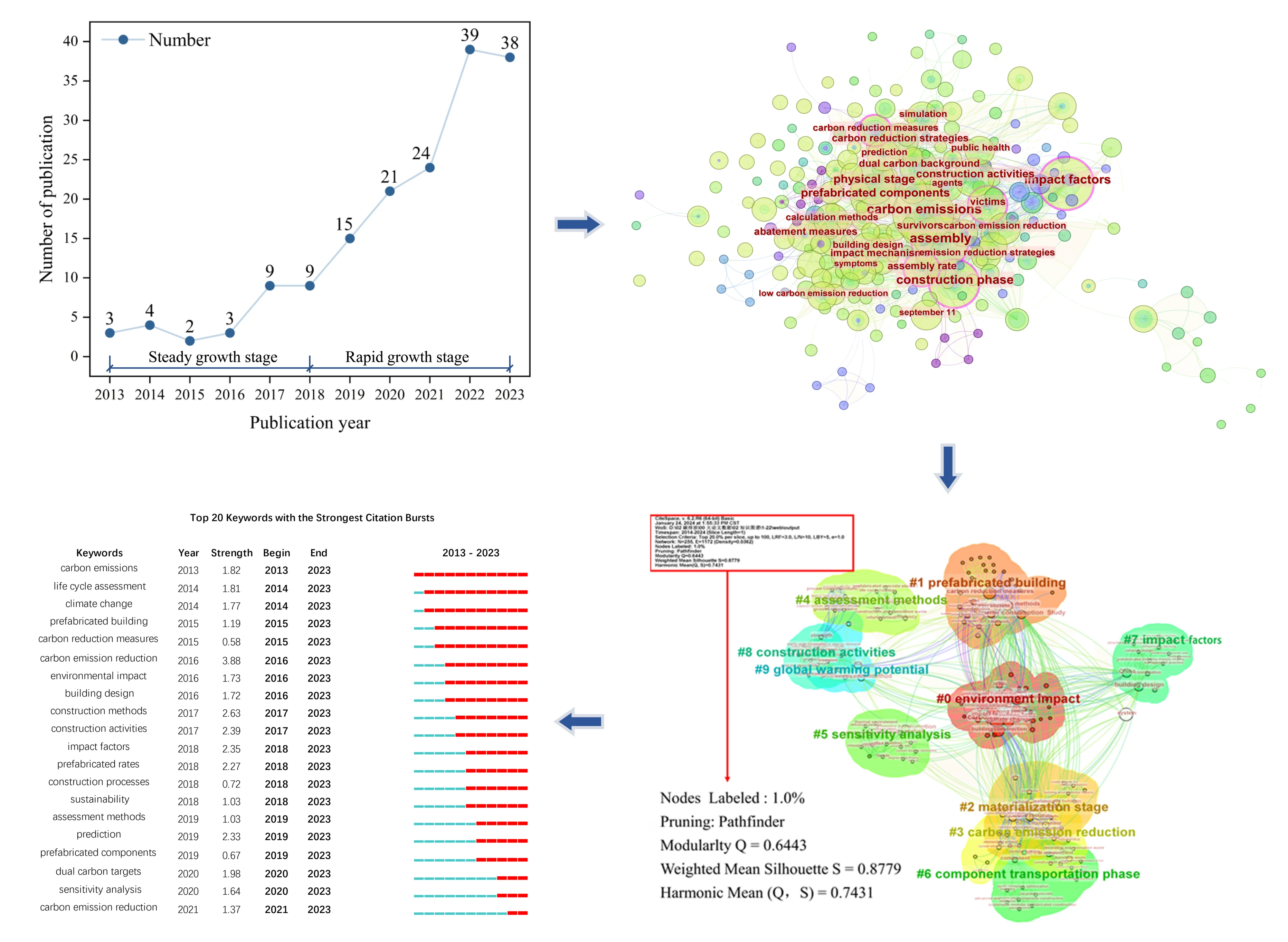
Highlights
- The study reveals a significant increase in research on carbon emissions during the construction stage of prefabricated buildings, particularly between 2019 and 2022.
- The study identifies ten distinct research clusters through knowledge graph analysis, showcasing the diversity and evolution of research in the construction stage of prefabricated buildings' carbon emissions.
- Life cycle assessment is the central focus in research on the construction stage of prefabricated buildings' carbon emissions, influencing various related topics like building costs and carbon reduction strategies.
1. Introduction
The construction industry, a significant source of carbon emissions, plays a crucial role in the global push for energy efficiency and emission reduction [1, 2]. Consequently, the industry must pursue a sustainable, green, and low-carbon development pathway [3]. Prefabricated buildings, recognized for their ability to minimize waste and enhance on-site system management, present substantial technical advantages in this regard [4]. With their rapid global expansion, prefabricated constructions hold a vast potential for cutting carbon emissions [5]. The lifecycle of a building encompasses several stages: production, construction, operation, and demolition. Among these, the construction stage is critical due to its short-term peak in emissions, highlighting it as a crucial point for intervention in carbon management strategies. This study leverages knowledge graphs to visualize and analyze the evolution of studies on carbon emissions specifically during the construction stage of prefabricated buildings (CSPB). By mapping out the key research areas and trends within this field, this study aims to delineate the current research priorities and future directions for reducing carbon emissions at this pivotal stage. Additionally, the findings serve as a valuable guide for further exploration into carbon management strategies in prefabricated construction, thereby supporting the broader goals of sustainable development in the construction industry.
2. Methodology
Knowledge graph is a large-scale semantic knowledge base that graphically represents the relationships between entities and attribute information [6]. This graphical representation helps to understand and process complex information. It reveals the dynamic development law of the knowledge domain and provides practical and valuable references for disciplinary research [7]. CiteSpace plays a vital role as a powerful literature analysis tool in constructing and analyzing knowledge graphs [8]. CiteSpace can visualize the structure of knowledge, and the graph generated by the software is called a scientific knowledge graph.
In order to obtain relevant literature in the field of carbon emissions during the CSPB, a search was conducted in the WoS database. The WoS database contains 20,300 journals and conferences. It is generally recognized as a high-quality database with considerable authority and reliability [9]. The accuracy of the bibliometric visualization depends on the choice of database and the design of the search method. To cover as comprehensively as possible the hotspots and current status of research related to carbon emissions during the CSPB, the scope of literature data retrieval in this study is the relevant literature published in the WoS database from 2013 to 2023.
Meanwhile, data outside the scope of this study was manually excluded when selecting the literature dataset. The specific screening criteria include the following three aspects:
(1) Exclude research data in non-construction fields.
(2) Exclude research data on carbon emissions from the macro-construction industry.
(3) Exclude research data that do not involve the quantification of carbon emissions.
In addition, the research framework of this study is shown in Fig. 1.
Fig. 1Research framework
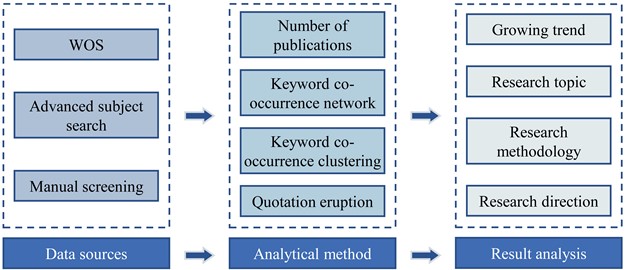
3. Scientometric analysis
3.1. Visual analysis of the number of publications
We searched the related literature data in the WoS database and finally screened 167 articles. The number and trend of published articles related to carbon emissions during the CSPB from 2013 to 2023 are shown in Fig. 2.
As shown in Fig. 2, the overall data from 2013 to 2023 shows a slow increase followed by a sharp increase. It can be divided into two stages: steady growth and rapid growth. 2022 is the peak of the growth of related papers published. Its publication volume increased by 62.5 % to 39. 2015 and 2023 showed a decreasing trend in the number of papers published in this field, but the number of decreases was insignificant. From 2019 to 2022, there was a substantial increase in papers published in this field, and the overall growth rate was significant. The above results indicate that the research in carbon emissions during prefabricated building construction is experiencing stable and sustainable development. It is widely concerned globally and has a relatively good research prospect.
Fig. 2Number of relevant academic articles from 20013 to 2023
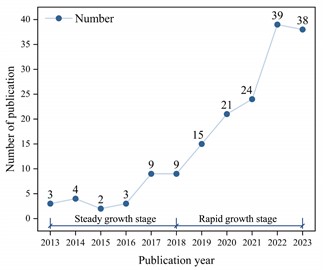
3.2. Visual analysis of keyword co-occurrence networks
Keywords are a high-level summary and condensation of the content of the paper. We perform co-occurrence analysis of keywords to identify hot research areas and directions. The minimum number of occurrences of a keyword was set to 12. Merge keywords with the same semantic meaning. The top 20 keywords are filtered out. The keyword contribution network is shown in Fig. 3, and the identified keywords are shown in Table 1.
Fig. 3Keyword co-occurrence network
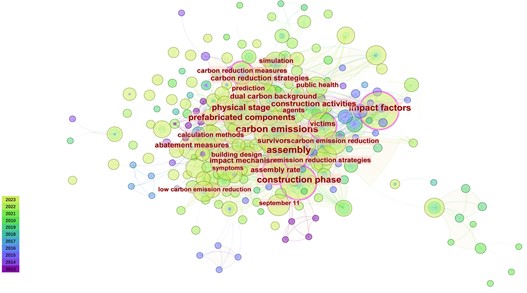
Table 1High frequency keywords
Number | Keyword | Frequency | Centrality | Number | Keyword | Frequency | Centrality |
1 | Life cycle assessment | 55 | 0.18 | 11 | Green building | 21 | 0.07 |
2 | Prefabricated building | 54 | 0.03 | 12 | Building construction | 21 | 0.1 |
3 | Carbon emissions | 37 | 0.02 | 13 | Carbon emissions | 19 | 0.02 |
4 | Environmental impact | 35 | 0.01 | 14 | Building design | 18 | 0.14 |
5 | Carbon reduction measures | 27 | 0.03 | 15 | Prefabrication | 15 | 0.15 |
6 | Impact factors | 26 | 0.05 | 16 | Climate change | 15 | 0.02 |
7 | Building costs | 26 | 0.19 | 17 | Prefabricated rates | 14 | 0.15 |
8 | Construction | 26 | 0.03 | 18 | Energy consumption | 13 | 0.04 |
9 | Project management | 25 | 0.02 | 19 | Case studies | 13 | 0.07 |
10 | Construction methods | 24 | 0.02 | 20 | China | 12 | 0.15 |
As can be seen from Table 1, life cycle assessment is the main scope of the current research on carbon emissions during the CSPB. According to the order of centrality, the current hot topics include building costs, prefabricated rates, and prefabrication, which indicates that the research focuses on prefabricated buildings. Construction is the most commonly used word and is paired with several keywords. In general, the research on carbon emissions during the CSPB is mainly centered on life cycle assessment and is developing towards diversification. In addition, the latest research topic involves prefabrication and case studies, indicating that the research on carbon emissions during the CSPB is currently receiving much attention.
3.3. Visual analysis of clustering for keyword co-occurrence
In order to further understand the research trends in the field of carbon emissions during the CSPB, we performed a cluster analysis of the keyword co-occurrence network graphs in the dataset. The timeframe of the cluster analysis is from 2013 to 2023. The different colors of the cluster analysis are the cluster themes, as shown in Fig. 4.
Fig. 4Keyword co-occurrence network graph cluster analysis
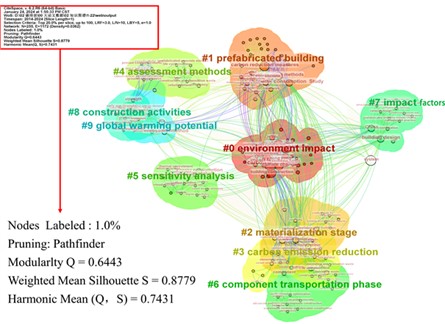
Ten keyword clusters were successfully identified in the dataset. As shown in Fig. 4, the module value is 0.644, and the average contour is 0.8779. Therefore, the keyword co-occurrence cluster analysis is highly reliable. The keywords are divided into ten classes from 0 to 9.
Cluster #0 is environmental impact. It indicates an early research direction in studying carbon emissions during the CSPB. The research keywords include energy consumption, climate change, and construction technology. It is centered on environmental impact. The early studies focus on the impact of carbon emissions caused by energy consumption on the environment and climate change. Cluster #1 is prefabricated buildings. It covers whole life cycle assessment, building environmental impact, and building information modeling. Cluster #2 is materialisation stage. It refers to the construction stage. This is because different researchers use different terms. The research hotspots revolve around carbon reduction, building construction, and building materials. Cluster #3 is emission reduction strategies. It focuses more on construction waste, technology, and management research. The treatment of construction waste is often neglected in past research. However, the amount of construction waste generated on construction sites is enormous. Therefore, construction waste disposal should be regarded as an integral part of the research on carbon emissions during the CSPB. Cluster #4 is assessment methods. Current research on carbon emissions gradually shifts to quantitative analysis, designing assessment models, carbon emission strategies, carbon reduction effects, and other topics. Cluster #5 is sensitivity analysis. Construction technology and model sensitivity analysis have become the focus of research in the cluster. Through sensitivity analysis, researchers can more accurately understand the model’s reliability and identify the key influencing factors of carbon emission. Thus, effective optimization strategies can be formulated. Cluster #6 is the component transportation phase. It contains research topics such as prefabricated rates and eco-efficiency. It explores the effectiveness and economic benefits of carbon reduction strategies. In addition, the prefabricated rate is a key parameter affecting the attributes of prefabricated buildings, which is gradually becoming a research hotspot. Cluster #7 is impact factors. Popular research topics include prefabricated building supply chains, building design, prefabricated rates, etc. The visualization results illustrate that the prefabricated rate is the critical impact factor of carbon emissions during the CSPB. Cluster #8 is construction activities, where popular keywords include building information modeling and construction management. Effective management of the construction site can significantly reduce the generation of carbon emissions during the construction stage. Cluster #9 is global warming potential. Carbon intensity and climate change are the hot research topics. Carbon intensity refers to the carbon emissions per unit of floor area or per unit of construction output value, which reflects the carbon emission efficiency of construction activities and is an essential parameter for evaluating the environmental impacts of construction projects and achieving the goal of green building.
3.4. Visual analysis of citation outbreaks
In order to identify and predict the latest progress and development trend of carbon emission research during the CSPB, we performed the identification of the keywords with the most robust citation outbreaks in the dataset based on the burst detection algorithm. The keyword threshold is set to Top20. The results are shown in Fig. 5.
In the top 20 keywords analyzed in the citation outbreak visualization, the Carbon emissions outbreak has the longest duration, from 2013 to 2023. The Carbon reduction measures keyword shows the highest intensity, suggesting that carbon reduction measures are a hot issue in literature research. The keywords with the solid intensity of citation outbreaks in the past five years include impact factors, prefabricated rates, and prediction. These keywords reflect the latest trends in the literature on carbon emission research during the CSPB.
Fig. 5Citation outbreak keywords
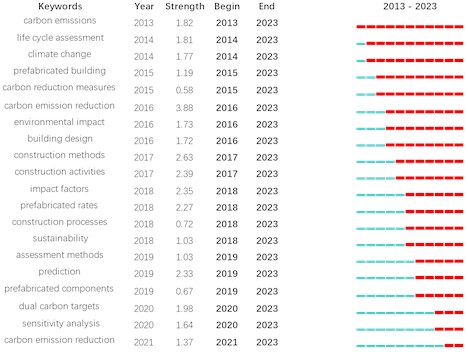
4. Conclusions
Carbon emissions are one of the main drivers of global climate change, posing a severe threat to human society and the natural environment. Through an in-depth study of carbon emissions during the CSPB, the level of carbon emissions and their impact on the environment at this stage can be more accurately understood and controlled. This study's research literature on carbon emissions during the CSPB in the WoS database was visualized and analyzed based on the CiteSpace knowledge graph visualization software. The analysis methods include academic paper issuance, keyword co-occurrence network, clustering of keyword co-occurrence network, and citation burst visualization. The conclusions are as follows.
1) International research on carbon emissions during the CSPB shows a growing trend, with an average increase of 41.42 % in the past ten years. This field is the current research hotspot.
2) Sorted according to the size of centrality, the current hot topics include building costs, prefabricated rates, and prefabrication.
3) We identify ten keyword clusters. The modular Q is 0.644, and the average contour s is 0.8779. This indicates significant cluster structure and reasonable results. We have illustrated each cluster to better introduce the research trend in carbon emissions during the CSPB.
4) The keywords that have shown vigorous intensity in the last five years are impact factors, prefabricated rates, and prediction. It reflects the latest direction in the literature for research on carbon emissions during the CSPB.
References
-
Q. Wang, X. Zhang, C. Guo, H. Zhou, Y. Zhao, and B. Lin, “Analysis of carbon emission differences between Chinese and Japanese buildings based on qualitative and quantitative comparisons,” Journal of Building Engineering, Vol. 89, p. 109260, Jul. 2024, https://doi.org/10.1016/j.jobe.2024.109260
-
S. Hu, Y. Zhang, Z. Yang, D. Yan, and Y. Jiang, “Challenges and opportunities for carbon neutrality in China’s building sector-Modelling and data,” Building Simulation, Vol. 15, No. 11, pp. 1899–1921, Jun. 2022, https://doi.org/10.1007/s12273-022-0912-1
-
X. Wang, L. Qu, Y. Wang, and H. Xie, “Dynamic scenario predictions of peak carbon emissions in China’s construction industry,” Sustainability, Vol. 15, No. 7, p. 5922, Mar. 2023, https://doi.org/10.3390/su15075922
-
L. Yu, Y. Wang, and D. Li, “Calculating and analyzing carbon emission factors of prefabricated components,” Sustainability, Vol. 15, No. 11, p. 8706, May 2023, https://doi.org/10.3390/su15118706
-
A. Xu, Y. Zhu, and Z. Wang, “Carbon emission evaluation of eight different prefabricated components during the materialization stage,” Journal of Building Engineering, Vol. 89, p. 109262, Jul. 2024, https://doi.org/10.1016/j.jobe.2024.109262
-
J. Lin, Y. Zhao, W. Huang, C. Liu, and H. Pu, “Domain knowledge graph-based research progress of knowledge representation,” Neural Computing and Applications, Vol. 33, No. 2, pp. 681–690, Jun. 2020, https://doi.org/10.1007/s00521-020-05057-5
-
C. Peng, F. Xia, M. Naseriparsa, and F. Osborne, “Knowledge graphs: opportunities and challenges,” Artificial Intelligence Review, Vol. 56, No. 11, pp. 13071–13102, Apr. 2023, https://doi.org/10.1007/s10462-023-10465-9
-
Q. Guo and P. Yao, “Bibliometric review of carbon peak with CiteSpace: evolution, trends, and framework,” Environmental Science and Pollution Research, Vol. 31, No. 9, pp. 13592–13608, Jan. 2024, https://doi.org/10.1007/s11356-024-32008-7
-
Z. Li, Q. Xiong, S. Li, W. Chen, N. Xu, and F. Qiu, “Quantitative analysis and visualization of literature on acupuncture and related TCM therapies for the treatment of colorectal cancer based on CiteSpace,” Frontiers in Oncology, Vol. 13, Jan. 2024, https://doi.org/10.3389/fonc.2023.1290588
About this article
This work was supported by the Chongqing Urban Rail Express Line Full Life Cycle CIM Technology Application Research and Demonstration Research Project (S20220413).
The datasets generated during and/or analyzed during the current study are available from the corresponding author on reasonable request.
The authors declare that they have no conflict of interest.
